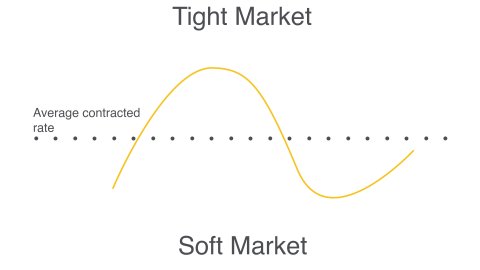It’s widely known that shippers prefer contracted agreements, and it’s easy to understand why: Contracts will bring you safety and security. Well, unfortunately that is an illusion. In tight markets, you will see rejection rates going up and quite often you end up in rogue exception and emergency management. And in soft markets, your rejection rates will go down to zero, giving you peace of mind and your contracts seem to be exactly the right strategy. However, we see a lot of shippers that prefer “easy” over “best” and a low rejection rate is a sign that you are likely paying more than your competitors. If you are not facing challenges to find capacity in tight markets and if you are fine with overpaying in soft markets, then you can stop reading here. Still here? Good!
14/12/2022
Strategies for a smart transport assignment mix

12/13/2022 | 9 min

Another interesting fact is that many shippers tend to procure and secure contracts for virtually all lanes, no matter if they will have actual volume for them or not – we refer to them as Ghost Lanes. Research found out that procuring ghost lanes is not good for the buyer. At the end, buyers must pay a higher price as they are loading up their procurement event with uncertainty, essentially. And finally, to become the shipper of choice for carrier's, it is essential to ensure you are attractive to carriers
So, what is the right approach? Before jumping into our recommendations and best practices, let’s first look at some myths and common mistakes we see out there when it comes to spot.
Myths about the Spot Market
Myth #1
Spot is more expensive – that depends, on a lot of factors. What we see is that a lot of shippers are using spot suboptimal, when you always run through your complete routing guide of carriers, precious lead time is passing. If you put such a load on the spot market in the late afternoon for loading on the next day there is a low chance of good offers so you end up paying more? Only using spot for exceptions, with short lead times and meaning not the most attractive loads (otherwise contracted carriers would have accepted) – is not giving you the best prices. That does not mean that we recommend to put 100% of your volume on spot, but we will come to that in our recommendations.
Myth #2
Carriers prefer only contracts and I am risking my good relationship with them if I move away from contract towards spot. Carriers like security as well which recently has been confirmed again via a TP survey. However, the majority of carriers do not want 100% contract, but are leaning more towards a 80/20 mix of contract and spot. Why is that? If you have ever worked on the carrier side, you will know about the dynamics and volatility within daily operations. Contracts are typically based on expected volumes, for example 20 loads per week. However, in reality, this does not translate into 4 loads per day (assuming 5 working days), sometimes it’s more, sometimes it’s less. Only in rare cases, shippers will be able to guarantee a fix volume for every single day. It’s this volatility that makes carriers prefer a mix. When moving away from a 100% contract strategy towards a more dynamic mix, it’s important to properly communicate to the carriers – we will get back to this important point in the recommendations.
Myth #3
I cannot guarantee the quality and reliability of the carriers if I go via the spot market. While this myth probably applies for some (open) freight exchange platforms that are out there and being used intensively by many large brokers, you are in full control of your carrier base within Transporeon. Only the carriers you define will get access to your shipments and your data. If as part of your new strategy you would like to bring in some additional high quality carriers into your carrier base, we will be able to support you identifying carriers that fulfill your requirements and are active on your lanes. Our Trust Center will simplify the exercise of onboarding new carriers and minimize the efforts on both end sides. You will always have the final say when it comes to adding a new carrier to your pool.
Myth #4
100% contracts (even for lanes where I am not yet sure there will be volume) is exactly the right strategy, especially in turbulent times. Investing time in procuring so called “ghost lanes” (lanes where no or only very low volumes are going to materialize in the upcoming period) has recently been investigated by MIT Researcher Angela Acocella. To summarize the findings, having a rate for every single lane, does not make sense and at the end of the day you are going to overpay, no matter if the market is tight or soft. If the market is tight and capacities are low, carriers will most likely reject the load on those lanes. And you will end up on the spot market paying the current market price, so your rate did not help, at all. If the market is soft, carriers will happily accept the load to their benefit. Again, you are overpaying. Shocking fact, according to the research, currently 70% of procured lanes are ghost lanes.
Still there? Ok, so now you are curious what you should do? Here are our recommendations and best practices when it comes to the “right mix of contract & spot”.
Guideline for a smart assignment strategy mix
First, challenge your current assignment strategy – that’s why you already started reading this article. Here are our recommendations towards a smart assignment strategy mix.
Plan contracted volume
Despite volatility, failing to plan still equals planning to fail. It still makes sense to devote a significant proportion of your procured lanes to your contracted carriers. Nurture your contractual relationships – long-lasting relationships with carriers have never been more important and will continue to offer both parties plenty of security in uncertain times. However, and as explained before, make sure to not procure ghost lanes, lanes that are likely to not materialize, and instead, put them into your spot planning..

Get tactical
Ensure to regularly check out spot price predictions and compare with contracted back up rates. We recommend maintaining flexibility allowing you to buy at spot rates if they’re better. As carrier rejection rates remain high, the spot market cements itself as an essential source of required capacity. Make sure to always keep yourself informed about current market developments. Today’s new normal includes managing exceptions, new lanes and business (where no contracted agreements exist) or managing exotic lanes more often than ever before – all of which demand the efficient use of the spot market. Use Market Intelligence and data-driven tools, to turn spot into more of a strategic and plannable option that can help ensure efficiency and competitive rates when things get hectic.
- Follow routing guide and commit to primary contracted carrier.
- In case of rejection of primary carrier, check the spot market and current conditions.
- Assign on the spot market if conditions are to your favor.
- If not, continue follow up the routing guide.
- Offer to next carrier and assign to accepted.

The right carrier for your loads
Considering new trade lanes or additional shipping options? Consider additional, suitable carriers with available capacity and bring these new carriers into your closed pool.
Offer spot transports that are attractive to your partners
- Make sure to also offer lanes on the spot market that are appealing to your carriers, not only lanes with low volume or remote destinations. Also consider seasonal fluctuation, remember that some carriers will prefer certain distances and geographies.
- “Be timely”, try not to request a load at 5 o clock in the afternoon for a pickup next morning.
- Add more flexibility and better matchmaking: Give your carriers the ability to find suitable return loads to avoid empty runs. Intelligent tools like ours let them find matching transports in real time.
- And finally - communication is key: Make sure to involve your carriers early, when moving to a more dynamic assignment strategy and position spot with the right spin and as a chance, not a threat. The world is dynamic and volatile, right? Instead of simply cutting contracted volume from carriers, give them access to consistent volume also on the spot market, enabling them to fill gaps in their planning. You will get them on board and aligned with your strategy much better, if you communicate the right way.
To summarize: Spot (should) happen.
When Spot is done and planned the right way, you as a shipper will benefit, and your carriers will do likewise. Both Shippers and carriers face similar challenges these days - Shippers need to find more agile ways in order to secure the capacity they need and to minimize transport costs. Carriers also need more dynamic and flexible ways of working so that they can secure sufficient business volume and reduce empty runs.
No matter what the market conditions are, having a vital pool of carriers with a smart mix of contract and spot, including attractive lanes, is essential! This will help you to react smarter no matter the market conditions as it will enable you to more efficiently secure capacities in tight markets and achieve cost savings when markets are softening.
Transporeon Transport Assignment Solutions deliver a holistic approach to managing a mix of contract and spot buying, powered by a combination of manual, rule driven, and data driven (artificial intelligence) tools.
When teams are equipped with digital tools, finding capacity is faster and more efficient every single time. To discover more on how to get the most out of the spot market or on finding the right mix of spot and contracted assignment, contact us if you want to discuss.
About the author
Jan Rzehak is the Director of Business Consulting at Transporeon. With more than 12 years of experience in logistics he has seen the digital transformations in the industry first hand, led numerous projects and helped shippers to improve their efficiency with solutions like transport execution, dock scheduling and vertical collaboration.


INFOGRAPHIC
Four steps to smart transport assignment and execution
The way we use the spot market has changed. Get smarter about how you plan and execute transports with a highly flexible assignment strategy. Work your way through our four simple steps to define your perfect mix of contract volumes and spot buying.


